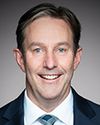Thank you, Mr. Chair.
The Canadian Association of Fire Chiefs would like to thank the Standing Committee on Health for the opportunity to express its views on Bill C‑224.
My name is Richard Amnotte, and I am the assistant director of the City of Lévis fire service and the second vice-president of the association's board of directors.
I am here today to lend my unwavering support to C‑224 along with our invaluable colleagues from the International Association of Fire Fighters, which represents thousands of firefighters in Canada.
Founded in 1909, the Canadian Association of Fire Chiefs represents the leaders of some 3,200 fire services across Canada, both permanent and volunteer. The association boasts an advisory board with representatives from each of Canada's provinces and territories, their fire chiefs' associations, as well as affiliated associations.
Our vision is to unite the leaders of the Canadian fire and rescue services. Our mission is to advance fire safety to ensure better protection against fire and other disasters across Canada.
Last week, nearly 40 Canadian fire chiefs were on Parliament Hill to meet with members of Parliament and members of the Senate from all parties and present the results of a major Canadian fire service survey and the state of fire services today, which is more critical than ever before.
We sincerely thank all MPs, senators and cabinet members for listening and being open-minded and open-hearted to the alarming findings and to the solutions we propose.
As our president, Ken McMullen, director of the Red Deer fire service in Alberta, so aptly put it, fire safety is a team sport, and we are all part of that team.
One of the requests that has been made is to ensure that there is an adequate response capability for firefighters in Canada. Every citizen, no matter where in Canada, is directly affected. The results of our survey were picked up by Ici Radio-Canada in 19 Canadian cities, in addition to CTV and Global TV, to name but a few.
According to our study, there are 126,000 firefighters in our great country, that is, 36,000 permanent firefighters and no less than 90,000 volunteer firefighters. Our survey also shows that there is a shortfall of more than 15,000 firefighters to adequately respond to the emergency calls of Canadians.
Several measures could be taken to recruit and maintain the necessary number of firefighters, and thus ensure better safety. These include increasing the tax credit for volunteer firefighters from $3,000 to $10,000, reinstating the joint emergency preparedness program to upgrade firefighters' equipment, maintaining funding for mental health programs for first responders, and passing Bill C‑224, An Act to establish a national framework for the prevention and treatment of cancers linked to firefighting.
Why is it so important to pass this bill? Cancer is simply killing too many firefighters. The bill is clear, consistent and respectful of the jurisdictions of different levels of government. It recognizes that a firefighter is a firefighter, whether he or she is from my home province of Quebec or from anywhere else in Canada, from a large city, a rural municipality or an aboriginal community, whether he or she is a permanent or volunteer firefighter, regardless of gender or age. Cancer does not discriminate.
Last week, more than 50 scientists, researchers and firefighters gathered in Ottawa for the first Canadian workshop on prioritizing cancer research in firefighters. We heard chilling accounts of the number of firefighters dying from cancer and other firefighting-related illnesses. The situation is alarming and concrete action must be taken immediately.
Bill C‑224 would provide a national framework for the research, prevention and treatment of firefighter-related cancers. It recognizes that the work of firefighters presents a particularly high level of risk because they work in a very different context, in a noble way, to protect the lives of Canadians from fire.
In conclusion, we sincerely thank MP Sherry Romanado for introducing Bill C‑224. We also thank all parliamentarians for being sensitive to the need to provide a better living environment for Canada's firefighters.
I reiterate our unwavering support for Bill C‑224.
Thank you.



